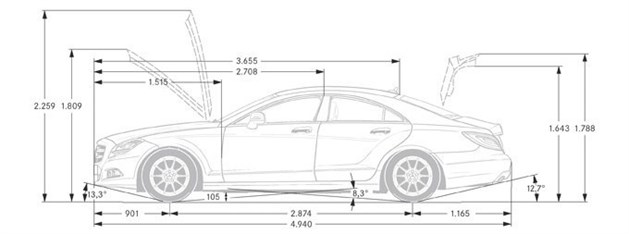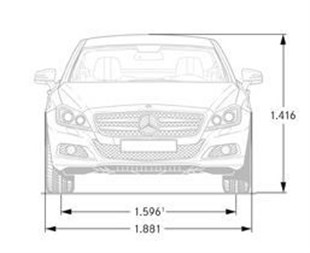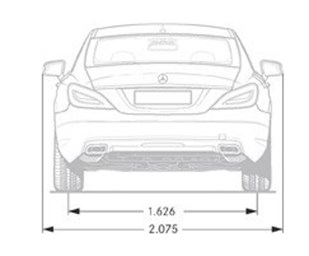Mercedes-Benz CLS (2011 – 2018) Review
Mercedes-Benz CLS (2011 – 2018) At A Glance
While some of Mercedes-Benz's other models of the last decade failed to capture buyers' imaginations (cars like the R-Class and GL-Class), the original CLS proved something of a surprise hit.
It combined the swoopy, slippery, shape of a coupe with the kind of practicality that you'd expect from a standard E-Class saloon and was a damned good drive to boot.
So it's more of the same for this, the new 2011 model, though there are some key differences in the details. Most importantly the engines are 25 per cent more efficient than before and there's the option (for the first time in a CLS) of a four-cylinder CLS 250.
This emits a scarcely believable 134-138g/km CO2, depending on which version you choose - that's cleaner (and cheaper to tax) than some hatchbacks. Even the CLS 500 - with its V8 engine - is now under 210g/km CO2.
Add to that all-LED headlamps (a world first for Mercedes-Benz), a range of safety systems, far more muscular styling, specialist paint finishes and more refinement throughout and you can really start to see where there's clear water between this and the original car launched in 2005.
Plus there's a new grille that bears more than a passing resemblance to the SLS supercar. But the CLS also manages to retain the styling features that buyers loved in the first place, including the long bonnet, narrow windows and sleek profile.
Although expensive, it's an excellent car. Though it needs to be. Back in 2005 it had buyers over a barrel - it was the only four-door upmarket coupe that you could buy. Since then both BMW and Audi have got in on the act with the 5 Series GT and A7 Sportback, both of which are very credible alternatives.
Mercedes-Benz CLS (2011 – 2018) handling and engines
- Engines range from CLS220 d to CLS63 AMG S
- Readers report Real MPG to be between 16–52 mpg
What's likely to be the best all-round engine in the CLS - the four-cylinder 204bhp CLS 250 CDI - isn't immediately available at launch, but it does manage to chalk-up some impressive figures, chiefly when it comes to CO2. Emissions from this engine will be between 134-138g/km CO2, putting it among some superminis when it comes to road tax - staggering for a car of this size.
Low CO2 always goes hand-in-glove with decent (official at least) fuel consumption figures. The CLS 250 CDI returns a claimed 55.3mpg on the combined cycle in official government tests - little wonder that this is the most important model.
The 350 CDI doesn't lag too far behind, with 159g/km CO2 (below the important 160g/km CO2 point for company car drivers) and a combined fuel consumption figure of 47mpg. It's an incredibly smooth, responsive and refined engine plus, with torque figures to compete with the V8 in the CLS 500, it's powerful too. It produces 265bhp and 620Nm of torque, which shows in the performance figures: 0-62mph takes just 6.2 seconds and it's capable of 155mph.
With two exceptional diesels on offer, it almost makes the CLS 350 petrol redundant. But this engine isn't without its merits. As you'd expect from a Mercedes-Benz V6, it's urgent when needed, while still being smooth enough for pounding hundreds of miles of motorway. It's relatively efficient for a petrol V6, too. Trouble is, after driving the CLS 350 CDI, you can't help but think that you're missing out.
Until the arrival of an AMG version (it's only a matter of time), the CLS 500 sits at the top of the range. This mighty engine boasts 408bhp and 600Nm of torque. And, if you're wondering, that's less than the 620Nm that's on offer from the CLS 350 CDI. As with the other engines, Mercedes-Benz has worked a minor miracle and has made a noticeable difference to emissions. The CLS 500 sees a 21 per cent drop, which means it now slides-in under 210g/km CO2 and returns 31.3mpg on the official combined cycle.
All petrol engines have a start/stop system for the first time with the 7G-TRONIC Plus gearbox. Diesels will get stop/start in future and get the standard 7G-Tronic gearbox that's operated from a stalk next to the indicator.
Making its debut on the CLS is a new Electromechanical steering system. What makes this different to others is that it makes a more direct connection between the driver, car and road. There's less to come between the input the driver makes by turning the steering wheel and it's outcome on wheels on the road. It's a system that seems to work well and the CLS turns sharply and changes direction accurately for a car of its size.
Like other recent Mercedes-Benz models such as the E-Class, the CLS is packed with safety systems - some of which are unique. As well as nine airbags (including pelvis bags at the front), Attention Assist is standard. This system works out when you're tired or not paying attention, based on steering inputs. If the system thinks that you need a break it'll flash up a warning on the HD display between the instruments.
PRE-SAFE works by priming the car for an impact in the seconds before an impact. At first the driver is given both an audible and and visual warning if the system identifies there is a danger of collision. If the driver does not react to this, the system takes over and brakes the vehicle. The emergency braking helps to reduce the severity of the impact.
Other safety features are optional and they include Active Lane-Keeping Assist (which gently brings the car back into lane if you stray by braking the wheels on the opposite side of the car and warns you through a vibration in the steering wheel) and Blind Spot Assist (visual warning in the wing mirrors and applies the brakes on the opposite side of the car). Highbeam Assist will dip the headlamps for you, while Nightview Assist Plus uses an infra-red camera to show obstacles in the view a night - essentially a posh version of the goggles that the army uses.
We wouldn't normally single out the headlamps for special mention, but in this case it's justified. The CLS is the first car in the world to feature all-LED headlamps, as an option, made up from 71 separate bulbs. Mercedes-Benz claims that they have an operating life that is five times longer than bi-xenons and offer an enhanced view of the road at night - though we've yet to try this for ourselves. The company also says that as the colour from LEDs is closer to that of daylight, it should mean less strain on the eyes of drivers of oncoming vehicles.
| Engine | MPG | 0-62 | CO2 |
|---|---|---|---|
| CLS220 d | 58 mpg | 8.5 s | 128 g/km |
| CLS250 CD | 54 mpg | 7.5 s | 135 g/km |
| CLS250 CDI | 54 mpg | 7.5 s | 138 g/km |
| CLS350 | 41 mpg | 6.1 s | 161–164 g/km |
| CLS350 CDI | 46 mpg | 6.2 s | 160 g/km |
| CLS350 d | 51 mpg | 6.5 s | 143 g/km |
| CLS400 | 38–39 mpg | 5.3 s | 169–170 g/km |
| CLS500 | 31 mpg | 5.2 s | 209 g/km |
| CLS63 AMG | 29 mpg | 4.2 s | 231 g/km |
| CLS63 AMG S | 29 mpg | 4.1 s | 231 g/km |
Real MPG average for the Mercedes-Benz CLS (2011 – 2018)

Real MPG was created following thousands of readers telling us that their cars could not match the official figures.
Real MPG gives real world data from drivers like you to show how much fuel a vehicle really uses.
Average performance
83%
Real MPG
16–52 mpg
MPGs submitted
161
Mercedes-Benz CLS (2011 – 2018) interior
- Boot space is 475–520 litres
| Dimensions | |
|---|---|
| Length | 4937–4967 mm |
| Width | 1881–2075 mm |
| Height | 1411–1418 mm |
| Wheelbase | 2874 mm |
On the outside, the CLS may look incredibly similar to the original car from 2005, but it's actually wider, with more space inside for all four passengers (the CLS is strictly a four-seater).
The interior quality is noticeably better than before, too, with high grade materials throughout and an emphasis on attention to detail, from the stitched dash that meets-up exactly with the corresponding stitching on the door, to the buttons and switches that wouldn't be out of place on a top-end stereo system.
There's also a wide range of finishes, including five interior colours, five trim designs and three different qualities of leather. Alcantara headlining is an option, too.
The coupe-like shape of the exterior is reflected in the driving position. The driver is cosseted by the dashboard, which wraps round the driver, almost like it would in a sports car. In front of the driver is a new colour HD display within the dials. It has many functions, from a humble trip computer to showing sat nav directions, what's on the stereo, speed information and vehicle warnings.
The driving position is infinitely adjustable, with electric steering wheel and seat adjustment. There's also the option of active seats. The side bolsters on these inflate as you corner to hold you in place and can be tuned to be more responsive.
It's incredibly quiet on the move and it's possible to do high speeds without wind rustle or hearing much of the engine. Sit in the back and you're treated to a generous amount of legroom, not quite enough to stretch right out, as you might in a limousine, but enough to make even long journeys comfortable. Headroom is OK for those of average height, though taller passengers may find that their heads come close to touching the roof lining because of the swooping roof line.
All passengers should notice how quiet it is on the move. Excellent sound-proofing means that wind and road noise are excluded and the engine is only audible under heavy acceleration. One of the CLS's main draws remains its practicality - the boot is huge. As well as the 520 litres on offer, the boot is easy load as it's close to the ground and, for the first, comes with the option of a beautifully engineered pull-out boot ‘bin' that folds out of the way when it's not needed.
Mercedes-Benz CLS (2011 – 2018) models and specs
| Dimensions | |
|---|---|
| Length | 4937–4967 mm |
| Width | 1881–2075 mm |
| Height | 1411–1418 mm |
| Wheelbase | 2874 mm |
| Miscellaneous | |
|---|---|
| Kerb Weight | 1735–1890 kg |
| Boot Space | 475–520 L |
| Warranty | 3 years |
| Servicing | 12500–15500 miles |
| Spare Wheel | |||
|---|---|---|---|
| Standard | Space-saving spare wheel | ||
| Costs | |
|---|---|
| List Price | £47,610–£88,675 |
| Insurance Groups | 36–50 |
| Road Tax Bands | D–L |
| Official MPG | 28.5–57.7 mpg |
| Euro NCAP Safety Ratings | |
|---|---|
| Adult | - |
| Child | - |
| Pedestrian | - |
| Overall | - |
On sale until June 2018
| Coupe | |||
|---|---|---|---|
| Version | List Price | MPG | 0-62 |
| CLS220d 2.1 AMG Line 7G-Tronic+ 4dr | £47,995 | 57.7 mpg | 8.5 s |
| CLS220d 2.1 AMG Line Premium 7G-Tronic Plus 4dr | £50,390 | 57.7 mpg | 8.5 s |
| CLS220d 2.1 AMG Line Premium Plus 7G-Tronic Plus 4dr | £51,590 | 57.7 mpg | 8.5 s |
| CLS350d 3.0 AMG Line 9G-Tronic+ 4dr | £52,085 | 51.4 mpg | 6.5 s |
| CLS350d 3.0 AMG Line Premium 9GT+ 4dr | £54,480 | 51.4 mpg | 6.5 s |
| CLS350d 3.0 AMG Line Premium Plus 9GT+ 4dr | £55,680 | 51.4 mpg | 6.5 s |
| CLS400 3.5 AMG Line 9G-Tronic+ 4dr | £57,395 | 37.7 mpg | 5.3 s |
| CLS63 5.5 S AMG Mct 7speed Auto 4dr | £88,675 | 28.5 mpg | 4.1 s |
On sale until June 2016
| Coupe | |||
|---|---|---|---|
| Version | List Price | MPG | 0-62 |
| CLS400 3.5 AMG Line 7G-Tronic+ 4dr | £55,860 | 39.2 mpg | 5.3 s |
On sale until September 2014
| Coupe | |||
|---|---|---|---|
| Version | List Price | MPG | 0-62 |
| 250 CDI 204 4dr Auto | £47,610 | 54.3 mpg | 7.5 s |
| 250 CDI AMG Sport 204 4dr Auto | £50,605 | 54.3 mpg | 7.5 s |
| 350 AMG Sport 306 4dr Auto | £54,245 | 40.9 mpg | 6.1 s |
| 350 CDI 265 4dr Auto | £51,250 | 46.3 mpg | 6.2 s |
| 350 CDI AMG Sport 265 4dr Auto | £54,245 | 46.3 mpg | 6.2 s |
| 63 AMG 557 4dr Auto | £81,950 | 28.5 mpg | 4.2 s |
On sale until December 2012
| Coupe | |||
|---|---|---|---|
| Version | List Price | MPG | 0-62 |
| 350 BlueEFFICIENCY 4dr Auto | £51,215 | 40.9 mpg | 6.1 s |
| 500 BlueEFFICIENCY Sport 4dr Auto | £63,050 | 31.4 mpg | 5.2 s |
Model History
- January 0001: 2010: New CLS unveiled
- November 2010: CLS63 AMG unveiled
- June 2014: New generation CLS revealed
January 0001
2010: New CLS unveiled
The proportions remain similar: long bonnet, narrow-look windows with frameless side windows, dynamic roof sweeping back at an angle towards the rear. The four-door Coupé from Mercedes-Benz immediately made its mark in 2003 as a new style icon. Now the proportions are the same - and yet everything is different: the second generation of this design trendsetter has adopted a completely new look.
Visually, the radiator grille is not integrated into the bonnet but is formed separately. This highlights the long, sporty bonnet even further. The grille is dominated by the large central star, which underlines the car's relationship to the other coupés of the brand and also enhances brand identity. The large, elongated dark air inlets with black grilles also add to the vehicle's athletic appearance.
The interior of the CLS combines straightforward elegance with innovative details and handcrafted perfection. An eye-catching feature is the wrap-around effect of the cockpit: a high line sweeps from the driver's door over the instrument panel support and across to the front passenger door. The central display has also been integrated harmoniously into the upper part of the instrument panel. At the same time, the downward sweeping side line on the doors continues the dynamic dropping line of the exterior. Dimensions Length: 4,940mm (+29mm over predecessor) / Width: 1,881mm (+8mm) / Height: 1416 (+13mm)



Handcrafting reflected in details such as the stitched seat covers or the so-called sewn covering for the dashboard. For the latter, the individual parts of the leather cover are sewn together by hand in a process which takes several hours, after which they are fitted and upholstered with high-quality foam. Prior to this process, the leather is also heated up to preshrink it, so that it will retain its shape even after extreme exposure to direct sunlight.
Customers can choose between three exclusive types of wood: high-gloss brown burr walnut, high-gloss black ash and satin-finish light-brown poplar. The wood has even been perfectly fitted around difficult contours for a masterful handcrafted finish, and the wood trim has been matched according to grain, as part of an elaborate selection process, to create a harmonised overall impression.
The interior can be given an even more progressive look with the addition of piano lacquer or carbon fibre trim elements. Handcrafted perfection once again plays a prominent role in the production process. Up to seven layers are applied and polished for the piano lacquer trim, for example, until the desired high-gloss finish is achieved.
November 2010
CLS63 AMG unveiled
The 'standard' car provides more than 500lb ft torque at just 1,750rpm, whilst the performance pack takes peak torque to nearly 600lb ft at 2,000rpm. For the latter, acceleration to 62mph takes a mere 4.3 seconds and it will reach a top speed of 186mph. The CLS63 AMG uses the company's new twin-turbo 5.5-litre V8, which replaces the naturally aspirated 6.2-litre V8 - cutting emissions by a whopping 113g/km and increasing fuel economy by 9.1mpg.
Like the S 63 AMG and CL 63 AMG, drivers of the CLS 63 AMG will benefit from an eight-cylinder powerhouse, designated internally as the M 157: the new AMG 5.5-litre V8 biturbo engine boasts a combination of innovative high-tech components which, in addition to spray-guided direct petrol injection with piezo injectors, also include a full aluminium crankcase, four-valve technology with camshaft adjustment, air/water intercooling, generator management and stop/start system.
With a displacement of 5461 cc, the eight-cylinder engine develops a peak output of 525 hp and torque of 700 Nm. In conjunction with the AMG Performance package, these figures increase to 557 hp and 800 Nm. Both variants of the CLS 63 AMG achieve exceptional performance: acceleration from 0-62 mph takes 4.4 and 4.3 seconds respectively, and the top speed is 155 mph (electronically limited).
The major difference between both power units is the increase in the maximum charge-air pressure from 1.0 to 1.3 bar. In addition, the CLS 63 AMG with the AMG Performance package features a special high-quality carbon fibre engine cover.
June 2014
New generation CLS revealed
The new generation CLS will arrive in the UK in September, featuring a new look and packed with new technology which is fitted as standard the new car promises to deliver even better value and lower emissions, as well as being the fastest and most efficient generation of CLS yet.
The range now starts with a new engine – the CLS 220 BlueTEC. Powered by a 2.1-litre diesel engine, the new addition generates 177PS and 129g/km of CO2. The second diesel model is the six-cylinder 350 BlueTEC – producing 258PS and emitting 142g/km. The CLS 350 BlueTEC engine is linked, for the first time, to an all-new nine-speed gearbox as standard – lowering CO2by 18g/km.
A new petrol six-cylinder engine has also been fitted to the CLS – the CLS 400 – taking the form of a 333PS, 3,498cc V6. Topping the range is the mighty CLS 63 AMG S – now producing 585PS (up 28PS) and 800Nm of torque (up 80 Nm) and it is equipped with a limited slip differential as standard. The changes bring down the 0-62 mph time from 4.2 seconds to 4.1 seconds.
Across the new CLS range there are significant upgrades in the technologies fitted, with AMG Line now becoming the default specification of the car. This means COMAND Online, heated front seats and the ambient lighting system are all fitted as standard (helping towards a saving of £5,695 over the model it replaces).
On every CLS a new eight-inch tablet-style screen is fitted as standard, running the latest ‘NTG 5’ software allowing new Mercedes-Benz apps, including the Mercedes Me system, to be downloaded and used in the car. LED Multibeam headlights are also fitted to the new CLS as standard – allowing benchmark visibility at night without dazzling other road users.
What to watch out for
2012 CLS 250 CDI recalled to have injectors replaced. Returned with far worse fuel economy. Suggests that original injectors that achieve EC CO2 emissions and economy are not robust enough to last and that stronger replacments are not as efficient.
22-09-2015:Recall in India of E-Class and CLS sold between April 2015 and May 2015 for a loose seal in the secondary bulkhead in the engine compartment. The loose seal can come in contact of the engine and lead to a fire.
12-06-2017:Report of rear brake pipe corrosion and split axle bushings on 92,500 mile 2011 Mercedes Benz CLS 350. Estimated bill £800.
10-11-2017:Report of fire in rear under load deck of 2014 Mercedes Benz CLS Shooting Brake.
26-11-2017:Another report of a fire in a Mercedes-Benz CLS250 CDI Shooting-brake. Owner had complained to Mercedes dealer about an intermittent burning smell coming from the rear end for some time but has been fobbed off by the dealer as something which will disappear over time. (Possibly the DPF actively regenerating at 800C.) Last week it eventually burst into flames on a friends drive. It was unoccupied fortunately but is a write off. Mercedes appears completely disinterested, claiming they have no knowledge of this occurring in any other CLS’s. Apparently there have been many instances and recalls in the US. This also appears to be a problem with UK models but no recalls and little cooperation from Mercedes.
13-12-2019:Report on a 9,689 mile 2016 Merceded-Benz CLS 350d of a faulty front SAM board sending rogue signals to the rear SAM board which is turning on the rear interior lights, this is draining the battery causing the cooling fan to kick in and drain the battery. Billed £168 for independent diagnosis and quoted £926 for replacement parts.

.jpg?width=640&height=426&rmode=crop)
.jpg?width=640&height=426&rmode=crop)
.jpg?width=640&height=426&rmode=crop)
.jpg?width=640&height=426&rmode=crop)
.jpg?width=640&height=426&rmode=crop)
.jpg?width=640&height=426&rmode=crop)
.jpg?width=640&height=426&rmode=crop)


 Big CO2 reductions. Four-cylinder CLS 250 CDI available at last. Precisely-built interior. Retains unique style of original CLS. Comes with full LED headlights.
Big CO2 reductions. Four-cylinder CLS 250 CDI available at last. Precisely-built interior. Retains unique style of original CLS. Comes with full LED headlights.
 Rear headroom tight for taller passengers. Options expensive.
Rear headroom tight for taller passengers. Options expensive.
.jpg?width=240&height=160&rmode=crop)

.jpg?width=240&height=160&rmode=crop)
.jpg?width=240&height=160&rmode=crop)


